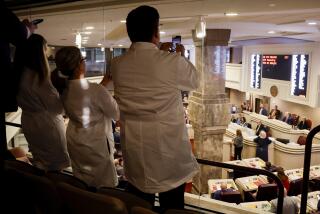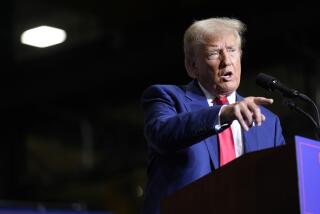Clinton Vows More Help in Breast Cancer Battle : Health care: President also seeks policies that afford wider access to mammography. Women will gain ‘equal footing’ under reforms, he says.
- Share via
WASHINGTON — Courting women’s support for health care reform, President Clinton called on state governments, insurance companies, medical facilities and businesses to adopt policies that broaden access to appropriate and affordable mammography. He also pledged additional government support for breast cancer research.
“These resources can save the lives of countless women,” the President said during an East Room ceremony as he signed a proclamation declaring today National Mammography Day.
Clinton also declared that it is time for the health care system to stop treating women as second-class citizens and said that his reform agenda will put them for the first time “on equal footing with men.”
The President was accompanied at the East Room appearance by First Lady Hillary Rodham Clinton, chief architect of his health care reform effort.
The plan has come under fire in recent weeks from some women’s health advocates, including some in Congress, who are critical of coverage planned for women under the Administration’s proposals.
A September draft of the health plan would provide free mammograms only to women 50 and older--and only at two-year intervals. In contrast, the National Cancer Institute and the American Cancer Society recommend mammograms for women after 40 either annually or every other year, with yearly mammograms after 50.
But Administration officials have said they are flexible on the final details. And as White House Press Secretary Dee Dee Myers said at Monday’s briefing, the public can “expect to see some changes” regarding mammography coverage in the final proposals, which are expected to be sent to Congress in the form of detailed legislation next week.
Administration health officials also have taken pains to note that women under 50 but deemed at high risk may have mammograms--or any other preventive procedure--at more frequent intervals so long as their primary care physicians prescribe the test. In such cases, the women likely would have to pay a fee.
Some women’s advocates are pushing for more frequent mammograms, but the President said Monday that his guidelines “are based on actual scientific evidence.”
“And one of the things that we need to make a commitment to do now is to update . . . all these preventive approaches as new and better studies become available, based on recommendations like those we will soon receive from the President’s Special Commission on Breast Cancer,” he said.
Dr. Susan Love, founder of the National Breast Cancer Coalition, a grass-roots organization that was behind Monday’s proclamation signing, said that Clinton’s plan would provide women “more than we have now” in terms of mammography coverage.
The coalition collected 2.6 million signatures--representing one signature for every woman in the United States with breast cancer--and presented them to the Clintons urging more funding for research.
The President said that under his budget, spending on breast cancer research will increase by 44%, from $208 million to almost $300 million at the National Institutes of Health. He also noted that several other agencies are spending more money on research programs.
And to further coordinate federal research and delivery efforts, Donna Shalala, secretary of health and human services, will convene a mid-December meeting of health professionals, government agencies and consumer groups “to develop a national action plan for the prevention, the diagnosis, the treatment of breast cancer,” Clinton said.
Breast cancer strikes an estimated one of every eight women, killing 46,000 annually. But, as Clinton noted, early detection can reduce the death rate by 30%.
* RELATED STORY: E1
More to Read
Sign up for Essential California
The most important California stories and recommendations in your inbox every morning.
You may occasionally receive promotional content from the Los Angeles Times.













